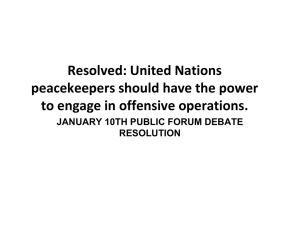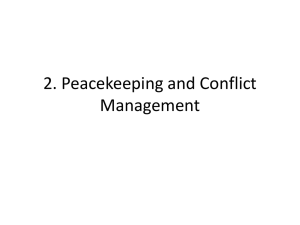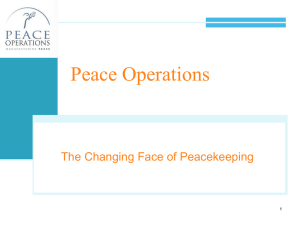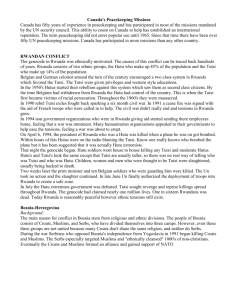Chapter 7 Notes and Questions #1
advertisement
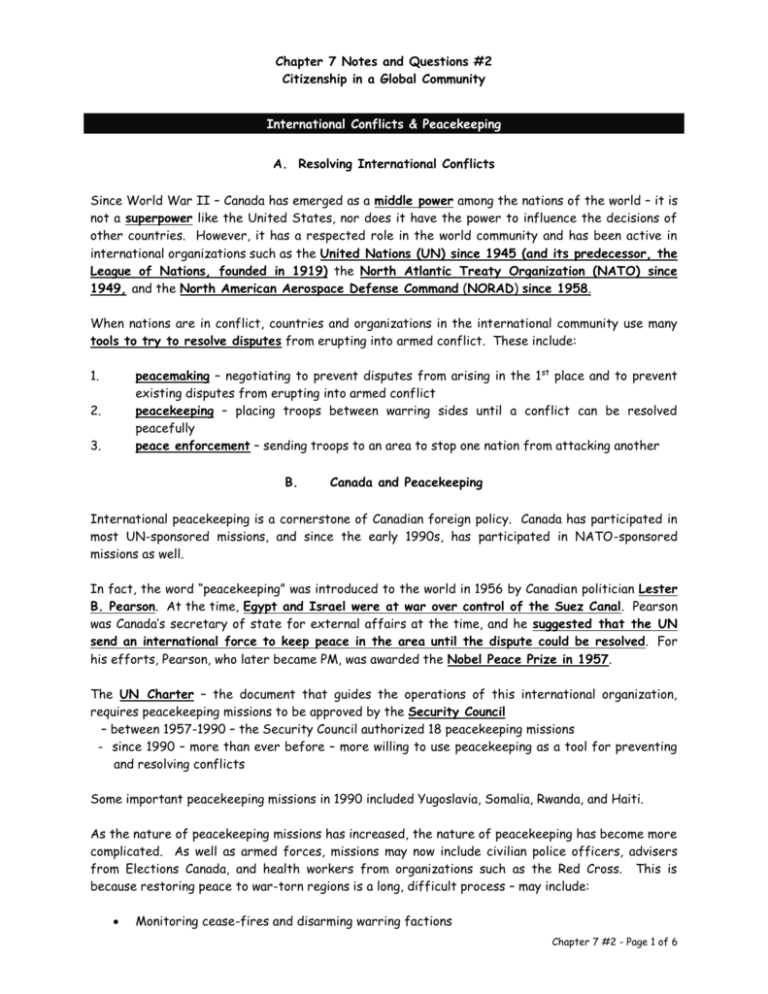
Chapter 7 Notes and Questions #2 Citizenship in a Global Community International Conflicts & Peacekeeping A. Resolving International Conflicts Since World War II – Canada has emerged as a middle power among the nations of the world – it is not a superpower like the United States, nor does it have the power to influence the decisions of other countries. However, it has a respected role in the world community and has been active in international organizations such as the United Nations (UN) since 1945 (and its predecessor, the League of Nations, founded in 1919) the North Atlantic Treaty Organization (NATO) since 1949, and the North American Aerospace Defense Command (NORAD) since 1958. When nations are in conflict, countries and organizations in the international community use many tools to try to resolve disputes from erupting into armed conflict. These include: peacemaking – negotiating to prevent disputes from arising in the 1 st place and to prevent existing disputes from erupting into armed conflict peacekeeping – placing troops between warring sides until a conflict can be resolved peacefully peace enforcement – sending troops to an area to stop one nation from attacking another 1. 2. 3. B. Canada and Peacekeeping International peacekeeping is a cornerstone of Canadian foreign policy. Canada has participated in most UN-sponsored missions, and since the early 1990s, has participated in NATO-sponsored missions as well. In fact, the word “peacekeeping” was introduced to the world in 1956 by Canadian politician Lester B. Pearson. At the time, Egypt and Israel were at war over control of the Suez Canal. Pearson was Canada’s secretary of state for external affairs at the time, and he suggested that the UN send an international force to keep peace in the area until the dispute could be resolved. For his efforts, Pearson, who later became PM, was awarded the Nobel Peace Prize in 1957. The UN Charter – the document that guides the operations of this international organization, requires peacekeeping missions to be approved by the Security Council – between 1957-1990 – the Security Council authorized 18 peacekeeping missions - since 1990 – more than ever before – more willing to use peacekeeping as a tool for preventing and resolving conflicts Some important peacekeeping missions in 1990 included Yugoslavia, Somalia, Rwanda, and Haiti. As the nature of peacekeeping missions has increased, the nature of peacekeeping has become more complicated. As well as armed forces, missions may now include civilian police officers, advisers from Elections Canada, and health workers from organizations such as the Red Cross. This is because restoring peace to war-torn regions is a long, difficult process – may include: Monitoring cease-fires and disarming warring factions Chapter 7 #2 - Page 1 of 6 Providing medical attention to the sick and injured Distributing relief supplies and helping refugees resettle in their homes Preventing the spread of disease Helping to organize a new government and hold elections In an effort to speed up response time to crises, the UN has created a 5000 member stand-by force, of which Canada contributes forces. In an emergency, these troops can be sent quickly to trouble spots where they stay until they are replaced by regular UN peacekeepers. C. Enforcing Human Rights Agreements Enforcing human rights agreements is one of the most challenging issues facing the world today. The nations of the world must decide what steps, if any, should be taken to deal with people who violate these agreements. During the 1990s, the UN tried to deal with a series of conflicts marked by extreme brutality. In countries such as Rwanda and the republics of the former country of Yugoslavia, people caught in the middle of these violent conflicts found they had become the target of genocide. 1. The Former Yugoslavia Since 1991 – bloody conflicts have been raging between different ethnic and religious groups who have been enemies for centuries. After WWI – Yugoslavia was created as a homeland for a variety of ethnic and religious groups that live in the Balkan Peninsula (East of Italy in Europe). After WWII – Yugoslavia was controlled for 35 years by the Soviet Union through the communist dictatorship of Josip Broz, who became known as Tito. When Tito died in 1980, Yugoslavia gradually began to break apart. During the early 1990s – various republics that had been part of the federation declared independence and were recognized as such by the UN. However, the government of Serbia, the largest and most powerful former Yugoslav republic, responded by sending troops into the area. Their mission was to protect the Serbs, most of which are Eastern Orthodox Christians, who lived in the breakaway areas. Bosnia and Herzegovina –one republic that declared independence – Muslims made up 44% of the population. When Serbian troops arrived, Muslims became the target of so-called ethnic cleansing (genocide), an organized campaign of terror and murder. At least 140,000 people were killed and another 2 million fled their homes. 2. Rwanda The Rwandan Genocide was the slaughter of an estimated 800,000 Tutsis and moderate Hutus mostly done by two extremist Hutu militia during a period of 100 days in 1994. In 1994, the presidents of Rwanda and neighboring Burundi met in Tanzania to talk about resolving the strife that was tearing apart both their countries. As the leaders flew home, their airplane was shot down and everyone on board was killed. Chapter 7 #2 - Page 2 of 6 The Hutu, who made up of 90% of the population of Rwanda, blamed Tutsi terrorists for shooting down the plane. Soon soldiers, police officers, militia, and civilians were participating in the systematic slaughter (genocide) of about 800,000 Tutsi in a matter of months. More than 2 million people fled the country. For many, the Rwandan Genocide stands out as historically significant not only because of the sheer number of people that were murdered in such a short period of time, but also because of the way many Western countries responded to the atrocities. Despite intelligence provided before the killing began, and international news media coverage reflecting the true scale of violence as the genocide unfolded, virtually all first-world / developed countries declined to intervene. The United Nations refused to authorize its peacekeeping operation in Rwanda at the time to take action to bring the killing to a halt. Despite numerous requests by Canadian Lieutenant-General Roméo Dallaire the UN peacekeepers on the ground were forbidden from engaging the militias or even discharging their weapons. In the weeks prior to the attacks the UN ignored reports of Hutu militias amassing weapons and rejected plans for a pre-emptive interdiction. This failure to act became the focus of bitter recriminations towards individual policymakers specifically, as well as the United Nations and countries such as France and the United States more generally and President Clinton specifically. Clinton was kept informed on a daily basis by his closest advisors and by the U.S. Embassy of Rwanda. Clinton was also advised by others close to him to "stay out of Rwanda" because of the possible political backlash similar to that which occurred just a year earlier in a failed attempt to help the country of Somalia in the Battle of Mogadishu (on which the movie, “Blackhawk Down” is based). The genocide was brought to an end only when the Tutsi-dominated expatriate rebel movement known as the Rwandese Patriotic Front, led by Paul Kagame, overthrew the Hutu government and seized power. Trying to escape accountability, hundreds of thousands Hutu "genocidaires" and their accomplices fled into eastern the Democratic Republic of the Congo. The violence and its memory continue to affect the country and the region. Source: http://en.wikipedia.org/wiki/Rwandan_Genocide 3. International Criminal Tribunals International Criminal Tribunals – set up by the United Nations to deal with genocides such as in Rwanda and the former Yugoslavia Purpose: to investigate crimes against humanity and bring to justice those who had committed them - Rwanda tribunal set up in 1994 Yugoslavia tribunal set up in 1993 Controversies: historically, the UN had become involved only in conflicts between nations i.e. Nuremburg trials of Nazi Germany – genocide of Jews across Europe however, in the case of Rwanda, it was set up to prosecute war ciminals who had committed their crimes only within the borders of their own country /a soverign nation – usually the Chapter 7 #2 - Page 3 of 6 - - - UN rules this a domestic affair and must be resolved by the people of the country in their own way some UN members argued that the UN tribunal interfered with domestic affairs others urged the UN to create a permanent tribunal to investigate human rights abuses, no matter where they occur, because they violate international human rights agreements International Court of Justice – deals only with disputes between governments – many argued that need a permanent court to deal with crimes against humanity which are committed by individuals some countries, ie. USA, did not want a PERMANENT tribunal that could interfere with their own domestic affairs others wonder if all human rights abuses would be treated equally in front of the permanent tribunal, i.e. would wealthy, powerful countries be treated the same as poorer, less powerful countries? UN tribunals criticized for taking too long to lay charges, or for not laying them at all. For example, NATO decision makers criticised for bombings during conflict with Serbia and Kosovo - International Court did lay charges against several countries, including Canada, for using force against another member country – still unresolved ** Louise Arbour – Ontario Supreme Court and Court of Appeal Justice who was appointed chief prosecutor of the Internaltion Criminal Tribunals for Rwanda and the former Yugoslavia by the UN Security Council The Hague – city in the Netherlands that is the base for the Rwanda and former Yugoslavia tribunals Mission of tribunals – to find out what had happened during the brutal conflicts in both countries and bring to justice those who had committed crimes against humanity On August 18, 1999 – Yugoslavia tribunal charged Slobodan Milosevic, president of Serbia, with committing war crimes – very important step because 1st time a serving head of state had been called to account for allegedly committing war crimes, and also showed no one above the law Unfortunately, Milosevic has been able to elude prosecutors and has not yet been brought to trial. In 1999, Arbour decided to leave the tribunal to accept an appointment to the Supreme Court of Canada. 4. Truth and Reconciliation Commissions Some countries take a different approach to human rights abuses. For example, after the end of apartheid in South Africa, the government decided to set up the Truth and Reconciliation Commission. Reconciliation means settling a conflict by helping the two sides accept and cooperate with each other. Commission’s goal – to promote national unity by healing the terrible wounds that had been inflicted during the arpartheid era. Under the leadership of Archbishop Desmond Tutu, the commission is hearing the stories of victims and making reparations – compensating victims for the harm suffered. The commission also has the power to grant amnesty to people who come forward and confess their crimes, with some conditions. Chapter 7 #2 - Page 4 of 6 Chilie, Argentina, and Brazil have established similar commissions to deal with human rights abuses that coccurred in the 1960s and 1970s when those countries had military dictators. It is important to note that truth and reconciliation commissions can only work if both sdes truly want reconciliation – if one side wants revenge it cannot work. Questions: 1. 2. 3. 4. 5. Why do some Canadians NOT support Canada’s active role in peacekeeping missions? Provide at least 2 examples. What are some of the criticisms of the UN standby force? What do you think should be done? Should it be the UN’s job to police the world? Explain why or why not. Is this an impossible job? Explain. In a paragraph, discuss the pros and cons of having a permanent tribunal for human rights abuses. In your answer, explain why some want it while others don’t and provide examples. Has the UN set a dangerous precedent by interfering in the internal affairs of some countries? Why? Chapter 7 #2 - Page 5 of 6 Peace and Conflict Assignment A. Chart As a class, you will complete a chart depicting Canadian involvement in peacekeeping and conflict incidents from the 20th and 21st centuries. In pairs, everyone will research two events on the chart. You need to provide the following information for your assigned case: - Canadian involvement Prime Minister and party in power at time of decision names of any international organizations involved general foreign policy at time with respect to Canada’s involvement in overseas conflict general attitude of Canadians toward the event and the government’s response values behind the government’s decisions on foreign policy. Once the chart is complete, have students work either individually or in their groups to synthesize the information from the chart in written form and answer the following in a three-paragraph essay: Examine/explain changes that have occurred in attitude, policy, and civic identity over time regarding Canada’s involvement in international incidents. You will be assessed for the thoroughness with which each conflict was examined in terms of each category (e.g., minimum of two relevant points per category). Your summaries and conclusions will be assessed in terms of how well you have used the information from the chart to support your answers as to why these changes in Canadian foreign policy occurred over time, and how Canadian civic identity is reflected in the changes. B. Research Once the chart is complete, each pair or individual must complete the following research assignment: Choose one peacekeeping/conflict event from the chart, and examine it for the following: 1. 2. 3. 4. At what point Canada decided to become involved (e.g., WWII, Afghanistan) or to not become involved (e.g., Vietnam War, Iraq 2003). In what ways Canada became involved (e.g., troops, money) Explain any controversies surrounding Canada’s involvement from a domestic or international perspective (i.e. WWII and French Canadians; Iraq 2003 and USA) General attitudes nationally and internationally about our involvement. After conducing your research, write a paragraph presenting your position on whether you feel Canada should or should not have been involved in the conflict, and why. You will also present this to the class. Your position on Canada’s involvement in a peacekeeping/conflict situation will be assessed in terms of: understanding of the historical facts of the issue with respect to the four points examined identification of the multiple points of view on the issue use of multiple sources to research the issue effectiveness of the communication method used. Chapter 7 #2 - Page 6 of 6
